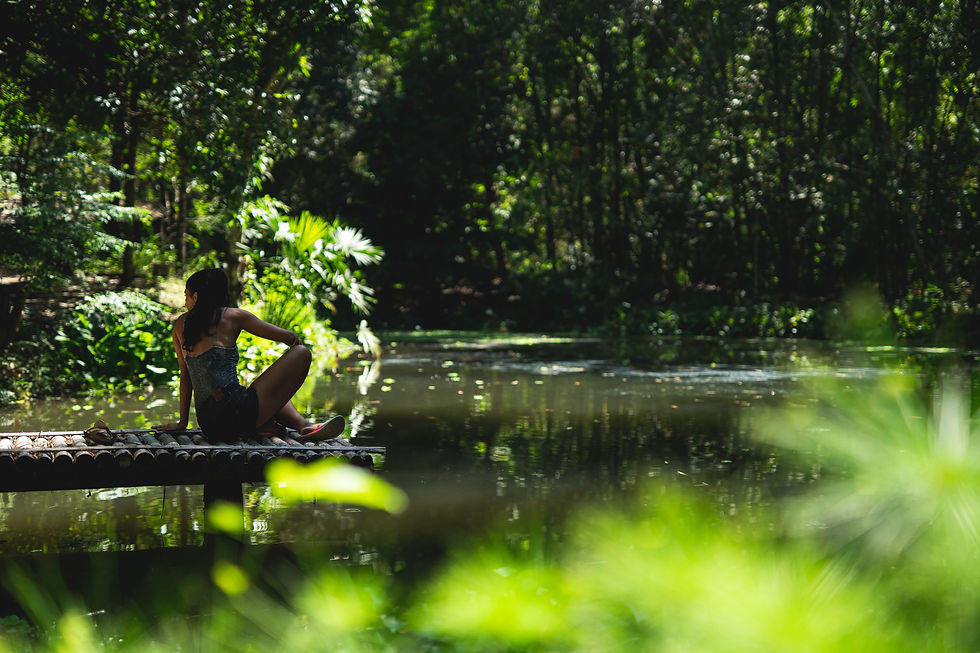The Mycelium Network: What Underground Fungi Teach Us About Connection
- reservabiologicaca
- Oct 13
- 4 min read

When you walk through the lush trails of Reserva Caoba, surrounded by towering trees and vibrant undergrowth, there's an entire world beneath your feet that you cannot see—a vast, intricate network that connects nearly every plant in the forest. This hidden web, made of thread-like fungal filaments called mycelium, is nature's original internet, and it has profound lessons to teach us about connection, community, and personal growth.
The Wood Wide Web
Beneath the Sierra Nevada's jungle floor lies one of nature's most remarkable collaborative systems. Scientists call it the "wood wide web"—a fungal network that links trees and plants in ways that challenge everything we thought we knew about forests. These mycelial threads, finer than the finest roots, extend for miles underground, creating a living communication network that allows trees to share resources, send warning signals, and even nurture their young.
Mother trees, the largest and oldest in the forest, use this network to recognize their own offspring and send them extra nutrients through the fungal channels. When a tree is attacked by insects, it releases chemical signals through the mycelium that warn neighboring trees to boost their defenses. Struggling trees receive carbon and nutrients from their healthier neighbors. The forest, it turns out, is not a collection of individuals competing for survival—it's a community that thrives through cooperation.

What the Forest Teaches Us About Human Connection
This underground network offers a powerful metaphor for our own lives. Like trees in a forest, we are not meant to stand alone. We thrive when we're connected, when we share resources, when we support each other's growth.
We're stronger when we're rooted in community. Just as a tree's health depends on its connections to the mycelial network, our well-being is deeply tied to the quality of our relationships. The strongest trees in the forest aren't necessarily the tallest—they're the ones with the deepest connections. In our own lives, building genuine connections with family, friends, and community creates resilience that helps us weather life's storms.
Giving and receiving are part of the same cycle. The mycelium network isn't a one-way street. Trees both give and receive nutrients, and the fungi themselves receive sugars from the trees in exchange for minerals and water. There's no shame in receiving help, just as there's no loss in giving it. In fact, both are essential to the system's health. When we embrace our interdependence rather than clinging to independence, we create space for mutual flourishing.
Communication prevents isolation. When trees share information about threats, the entire forest becomes more resilient. Similarly, when we open up about our struggles, share our experiences, and communicate honestly, we create protective networks around ourselves and others. Vulnerability isn't weakness—it's the mycelium that connects us.

Cultivating Your Own Network
So how do we apply these forest lessons to our daily lives? Here are some practical ways to nurture your own "mycelial" connections:
Tend your roots. Just as mycelium requires healthy soil to thrive, our connections need attention and care. Reach out to friends you haven't spoken to in a while. Show up for your community. Small, consistent acts of connection are like the invisible threads that strengthen the entire network.
Be a mother tree. If you're in a position of strength or experience, look for opportunities to mentor, support, or simply listen to those who are struggling or just starting out. The wisdom and resources you share will enrich the entire community.
Accept the nutrients others offer. When someone offers help, advice, or support, practice receiving it gracefully. This isn't dependence—it's participating in the natural cycle of give and take that makes communities resilient.
Create spaces for connection. Whether it's hosting a dinner, organizing a hiking group, or simply making time for meaningful conversation, be intentional about creating environments where genuine connection can happen.

The Forest's Invitation
When you visit Reserva Caoba, take a moment to place your hand on the trunk of an ancient tree. Close your eyes and imagine the invisible network beneath your feet—the countless connections, the silent sharing of resources, the constant communication happening in the darkness of the soil. You're standing on a living example of what's possible when individual beings prioritize connection over isolation.
The forest doesn't teach us to be self-sufficient. It teaches us that true strength comes from being woven into something larger than ourselves. It shows us that we grow taller when we're rooted together, that we're more resilient when we share our struggles, and that the most magnificent ecosystems are built on invisible acts of generosity happening beneath the surface.
Perhaps the most profound lesson of the mycelium network is this: you are not alone, even when you feel isolated. Like the trees, you are part of a larger web of connection, and your well-being is inseparably linked to the well-being of others. The question isn't whether you need connection—the question is how you'll choose to nurture it.
Ready to experience the wisdom of the forest firsthand? Visit Reserva Caoba and immerse yourself in the Sierra Nevada's teaching jungle, where every trail reminds you that we all grow better together.





Comments